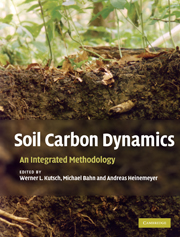Book contents
- Frontmatter
- Contents
- List of Contributors
- Preface
- Editorial Acknowledgements
- 1 Soil carbon relations: an overview
- 2 Field measurements of soil respiration: principles and constraints, potentials and limitations of different methods
- 3 Experimental design: scaling up in time and space, and its statistical considerations
- 4 Determination of soil carbon stocks and changes
- 5 Litter decomposition: concepts, methods and future perspectives
- 6 Characterization of soil organic matter
- 7 Respiration from roots and the mycorrhizosphere
- 8 Separating autotrophic and heterotrophic components of soil respiration: lessons learned from trenching and related root-exclusion experiments
- 9 Measuring soil microbial parameters relevant for soil carbon fluxes
- 10 Trophic interactions and their implications for soil carbon fluxes
- 11 Semi-empirical modelling of the response of soil respiration to environmental factors in laboratory and field conditions
- 12 Modelling soil carbon dynamics
- 13 The role of soils in the Kyoto Protocol
- 14 Synthesis: emerging issues and challenges for an integrated understanding of soil carbon fluxes
- 15 Appendix: Towards a standardized protocol for the measurement of soil CO2 efflux
- Index
- References
8 - Separating autotrophic and heterotrophic components of soil respiration: lessons learned from trenching and related root-exclusion experiments
Published online by Cambridge University Press: 11 May 2010
- Frontmatter
- Contents
- List of Contributors
- Preface
- Editorial Acknowledgements
- 1 Soil carbon relations: an overview
- 2 Field measurements of soil respiration: principles and constraints, potentials and limitations of different methods
- 3 Experimental design: scaling up in time and space, and its statistical considerations
- 4 Determination of soil carbon stocks and changes
- 5 Litter decomposition: concepts, methods and future perspectives
- 6 Characterization of soil organic matter
- 7 Respiration from roots and the mycorrhizosphere
- 8 Separating autotrophic and heterotrophic components of soil respiration: lessons learned from trenching and related root-exclusion experiments
- 9 Measuring soil microbial parameters relevant for soil carbon fluxes
- 10 Trophic interactions and their implications for soil carbon fluxes
- 11 Semi-empirical modelling of the response of soil respiration to environmental factors in laboratory and field conditions
- 12 Modelling soil carbon dynamics
- 13 The role of soils in the Kyoto Protocol
- 14 Synthesis: emerging issues and challenges for an integrated understanding of soil carbon fluxes
- 15 Appendix: Towards a standardized protocol for the measurement of soil CO2 efflux
- Index
- References
Summary
INTRODUCTION
Soil respiration (RS, Fig. 8.1) is the sum of an autotrophic component (RA) produced by roots and the associated rhizosphere (mycorrhizae and rhizosphere bacteria) and a heterotrophic component (RH) originating from soil micro-organisms that decompose the organic materials from both above-ground and below-ground litter (Bowden et al., 1993; Boone et al., 1998; Epron et al., 1999). Autotrophic respiration involves root carbohydrates and root exudates that have very low residence time in soil, while the heterotrophic component involves carbon compounds with a longer residence time, ranging from months to years for fresh litter and from years to centuries for old soil organic matter. All components are thought to be differently influenced by climatic conditions and site characteristics (Boone et al., 1998; Epron et al., 2001; Lavigne et al., 2004; Dilustro et al., 2005) and are thought to respond differently to elevated atmospheric CO2 or soil warming (Rustad et al., 2001; King et al., 2004; Pendall et al., 2004; Soe et al., 2004; Eliasson et al., 2005). Thus, separate estimations of these components are required for analyzing and modelling soil respiration and its response to climate or perturbation, for providing a better knowledge of carbon budgets of ecosystems and for improving carbon sequestration in soil (Hanson et al., 2000; Ryan and Law, 2005; Subke et al., 2006).
- Type
- Chapter
- Information
- Soil Carbon DynamicsAn Integrated Methodology, pp. 157 - 168Publisher: Cambridge University PressPrint publication year: 2010
References
- 11
- Cited by

